MVP in Product Management: Is it Really a Big Deal?

The best products today didn't start fully built. They started small by building an MVP in product management.
Think of fast-launch startups like Airbnb, Dropbox, and Buffer. What do they all have in common? They each began with a Minimum Viable Product—a mainstay of lean startup methodology.
Mind you, it's not just the tech giants using this product development strategy.
According to GoodFirms' 2024 survey of 680 businesses, 91.3% use the MVP model, and 74.1% plan to continue using it for future launches.
 MVP in product development process is essential (Source: GoodFirms)
MVP in product development process is essential (Source: GoodFirms)So yes, it's a big deal.
However, a successful MVP in product management takes more than copying others. You need to know how to apply it effectively, when to use it (and when not to), and how to measure success.
In this blog, we’ll explore what MVP means in product management, why it matters, and how to use it strategically.
What is a Minimum Viable Product (MVP)?
In product management, an MVP is the simplest version of a product that still delivers value to real users. Before we get into details, let's first understand what an MVP isn't.
Many teams treat MVPs as half-built products or quick-and-dirty launches. That's not what Eric Ries—the author of The Lean Startup and the person who coined the term—had in mind.
An MVP is not:
- Feature-stuffing:
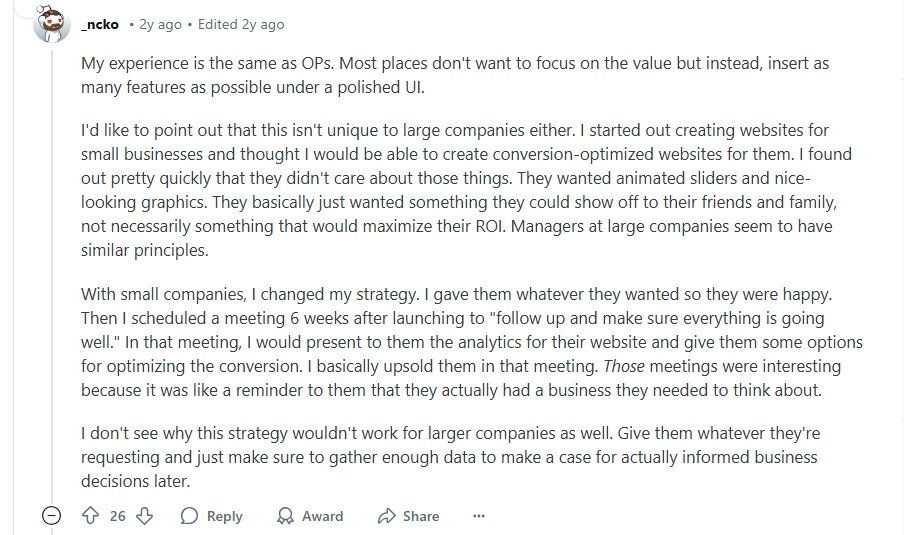 MVP isn't a product with the maximum amount of features (Source: Reddit)
MVP isn't a product with the maximum amount of features (Source: Reddit)- A low-quality prototype:
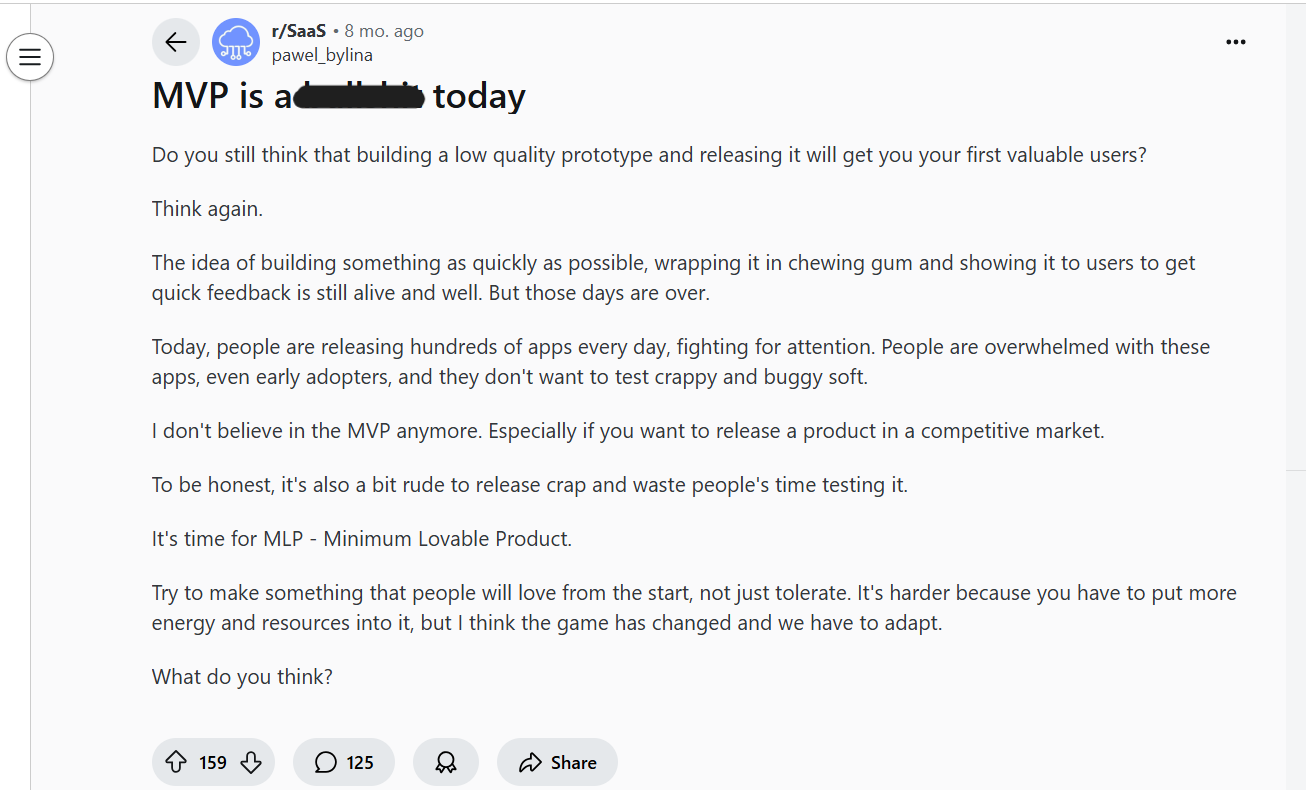 MVP isn't a low-quality prototype (Source: Reddit)
MVP isn't a low-quality prototype (Source: Reddit)So, again, what is an MVP?
A Minimum Viable Product is an early version of a product that includes just enough core features to attract early adopters and validate a product idea. It typically appears in the initial stages of the product lifecycle. Teams design it to collect feedback quickly and guide future development. The concept is rooted in Agile methodology and emphasizes rapid iteration and learning from real users.
At first glance, MVP in product management might sound like putting out a bare-bones version of your product. But that approach no longer works.
A high-impact MVP is well-defined and focused. Henrik Kniberg, former Agile development coach at Spotify and LEGO, illustrates this perfectly:
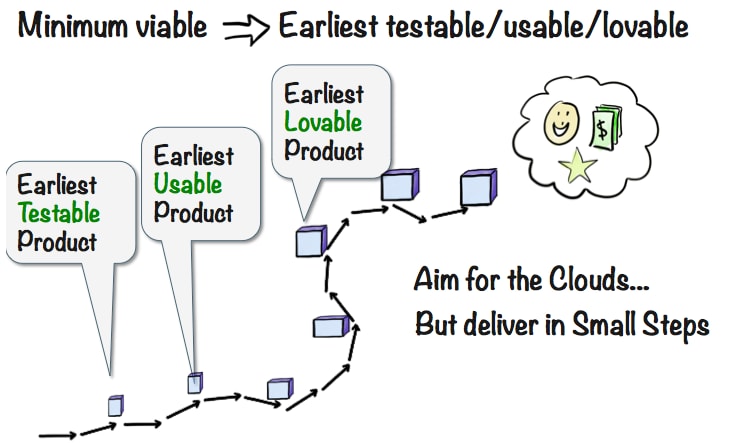 The real definition of a Minimum Viable Product, MVP (Source: Crisp)
The real definition of a Minimum Viable Product, MVP (Source: Crisp)Is an MVP just another prototype?
Not quite. Here's the key difference between prototype and MVP:
- Prototype: A preliminary model used to explore ideas, test functionality, or visualize a concept. It's often incomplete, not fully functional, and rarely intended for real users. Think of it as an internal tool for testing feasibility or design.
- MVP: A working product with enough features to solve a real problem for real users. Teams use it to collect feedback, validate market demand, and inform what comes next.
Summary: A prototype helps you learn if you can build something. An MVP validates if you should.
Benefits of MVP in Project Management
Yes. An early-stage product offers real, measurable benefits across speed, cost, and collaboration.
Take Yazi, a South African startup, as a case study. They initially built a custom WhatsApp bot for data collection—but it failed to attract clients. So they pivoted to a no-code bot builder. The result? Faster deployment, lower costs, and real user validation. That shift helped them refine their product and reach underserved communities.
Let's unpack the upside:
Faster time-to-market
MVPs help teams launch quickly by prioritizing core functionality. Instead of spending months building a full-featured product, you release a simplified version that solves a core problem. This way, you can:
- Get early feedback
- Test product-market fit
- Iterate faster
For startups, faster time-to-market creates momentum. For established teams, it tightens the loop between idea and execution, saving time and preventing wasted effort.
Lower development risk and cost
Building full products before testing demand is risky. MVPs reduce that risk by:
- Requiring only essential features
- Cutting dev time and costs
- Validating ideas before large-scale investment
If your MVP fails, it's a low-cost lesson. If it succeeds, you've validated your direction with real users. Either way, you're making informed decisions.
Stronger team alignment
A well-defined MVP forces alignment. Product, design, engineering, and marketing all focus on solving one specific problem for just one user. That clarity:
- Sharpens priorities
- Streamlines collaboration
- Speeds up execution
With a tight scope and a measurable outcome, teams move faster and with confidence.
Suggested Read: 👉8 Stages of the New Product Development Process
Can an MVP fail—and still be valuable?
Absolutely!
Case Study: Google Glass Google Glass was an ambitious MVP launched by Google with a lot of hype. However, it ultimately failed to gain widespread adoption due to issues like privacy concerns, limited functionality, and an overly high price tag. Despite the product's failure, it provided Google with invaluable insights into consumer preferences and the viability of augmented reality (AR) technology.
A failed MVP can be one of the most valuable outcomes in product management. Here's how:
- If users don't engage or conversions are poor, that's not a failure. It's a signal.
- You've learned that the market isn't ready, the problem isn't pressing, or the solution misses the mark.
That's actionable feedback—not failure.
When to use it and when not to
Use an MVP when:
- Testing a new product idea
- Entering a new market
- Prioritizing speed and learning over perfection
MVP in product management is also effective for internal innovation, allowing teams (especially early-stage startups or lean teams) to test bold ideas without the friction of long approval cycles.
Avoid building MVPs when:
- Building in heavily regulated industries (healthcare, fintech, govtech)
- The market is already well understood and validated
- Your team isn't equipped to act on feedback, whether due to logistical challenges, cultural fit, or resource constraints
In these cases, a stripped-down version can hurt by undermining trust, creating compliance risks, or wasting team effort.
Summary:
| When to Use an MVP | When Not to Use an MVP |
|---|---|
| Testing a new product idea | Building in heavily regulated industries (e.g., healthcare, fintech, govtech) |
| Entering a new market | The market is already well understood and validated |
| Prioritizing speed and learning over perfection | Your team isn't ready to act on feedback due to logistical, cultural, or resource limitations |
Now, let's break down how to build an effective MVP that delivers.
How to build an effective MVP in 5 steps
These five steps will help you design, deliver, and validate an MVP that solves real user problems without overbuilding. Each one outlines what success will look like, how to measure it, and how Meegle can support the process.
TL;DR:
| Step | What Success Looks Like | How to Measure It | How Meegle Helps |
|---|---|---|---|
| Define the problem and target user | Clear problem statement and user profile | Team alignment, documented use cases | Node workflows for mapping pain points and personas; real-time comments for cross-team input |
| Outline core functionality | A focused backlog targeting one core issue | Feature clarity, scope buy-in, prioritization logic | Project Life Cycle template, version tagging, and prioritization frameworks (MoSCoW, ICE) |
| Build a prototype or mockup | A usable, testable prototype that reflects real flows | Speed of delivery, design completeness, team feedback | Visual workflows, team role mapping, task ownership, and dependency tracking |
| Launch and gather feedback | Actionable feedback tied to MVP features | Qualitative insights, key metric shifts | Node Forms for logging feedback; charts for tracking metrics like retention and task completion |
| Iterate based on insights | Roadmap shaped by data, not assumptions | Faster iteration cycles, measurable impact | Milestone planning, feedback analysis tools, and roadmap alignment across teams |
Step 1: Define the problem, value proposition, and your target user
A strong MVP starts with a real, validated problem, and a specific user who feels it most. Skip this, and you risk building on assumptions, wasting time, or shutting down entirely.
To stay grounded in real user needs, start by asking these questions:
- What problem are we solving? → e.g., Teams waste hours switching between tools to manage projects.
- Who experiences this problem most often? → e.g., Startup operations managers juggling fast-moving teams and limited tools.
- Why is it worth solving now? → e.g., As remote work rises, tool overload is stalling execution and burning out teams.
Example:
Instead of saying: We want to help teams collaborate.
Say: We help startup ops managers reduce tool-switching by centralizing project execution.
- What success looks like: A documented problem statement and clearly defined user profile.
- How to measure it: Cross-functional agreement, clear use cases, and team alignment.
How Meegle helps:
Use Meegle's node-driven workflow to map the user journey, surface pain points, and capture early hypotheses.
 Sample template for lean startups
Sample template for lean startupsCreate separate nodes for the:
- Problem statement
- Value proposition
- User profile
This gives everyone a shared foundation.
Each node supports real-time comments and task assignments, so all involved teams can contribute without syncing live. You can also tag teammates, attach supporting research, and build early alignment—before writing a single line of code.
Related read: 👉7 Product Roadmap Examples to Guide Your Strategy
Step 2: Use feature prioritization to outline core MVP functions
Feature prioritization helps you identify the "minimum set of features" needed to solve users' core problem. As such, it is only natural that it comes immediately after you've defined the problem and user.
Without feature prioritization, you might end up with features users don't want. To stay lean, apply prioritization frameworks like:
- MoSCoW (Must have, Should have, Could have, Won't have): Helps teams categorize features by urgency and value, aligning scope with real needs.
- ICE (Impact, Confidence, Effort): Balances potential payoff with feasibility, making it ideal for comparing competing features.
| Framework | Why Use It | When to Use It |
|---|---|---|
| MoSCoW (Must have, Should have, Could have, Won't have) | Quickly clarifies what's essential vs. nice-to-have; great for team alignment. | When you need to scope features for early delivery and align cross-functional teams fast. |
| ICE (Impact, Confidence, Effort) | Helps weigh feature value against cost and uncertainty; encourages evidence-based decisions. | When you're choosing between multiple features and need to justify trade-offs with limited data. |
Example:
For a remote feedback tracker MVP:
- Must-haves: a centralized comment feed and tag-based search
- Nice-to-haves: Slack notifications or upvote functionality
The goal: solve one core user problem with the smallest set of high-impact features.
- What success looks like: A focused product backlog that targets one problem, with only essential, user-validated features.
- How to measure it: A clearly prioritized feature set, alignment among stakeholders, and a defined MVP phase—a focused slice of functionality that's realistic to build, test, and learn from.
How to use Meegle for feature prioritization:
You can use Meegle's Project Life Cycle template to break down your product vision into phases and map each feature to the right stage of development.
 Break product vision into phases for value proposition
Break product vision into phases for value proposition- Prioritize what matters most: You can tag nodes based on MVP relevance (e.g., Must-have, Nice-to-have), assign priorities, and use custom labels like "User-validated" or "Blocked" to track progress. This ensures your backlog stays lean and focused.
- Align stakeholders in real time: Meegle's node-based commenting allows PMs, designers, and engineers to give input directly on each feature card. That means no more misalignment or siloed decisions; the feedback stays tied to the feature being discussed.
- Define the MVP phase clearly: Group nodes into a scoped MVP milestone, so everyone sees exactly what’s in (and out) of scope. This reduces confusion and helps the engineering plan deliverables more accurately.
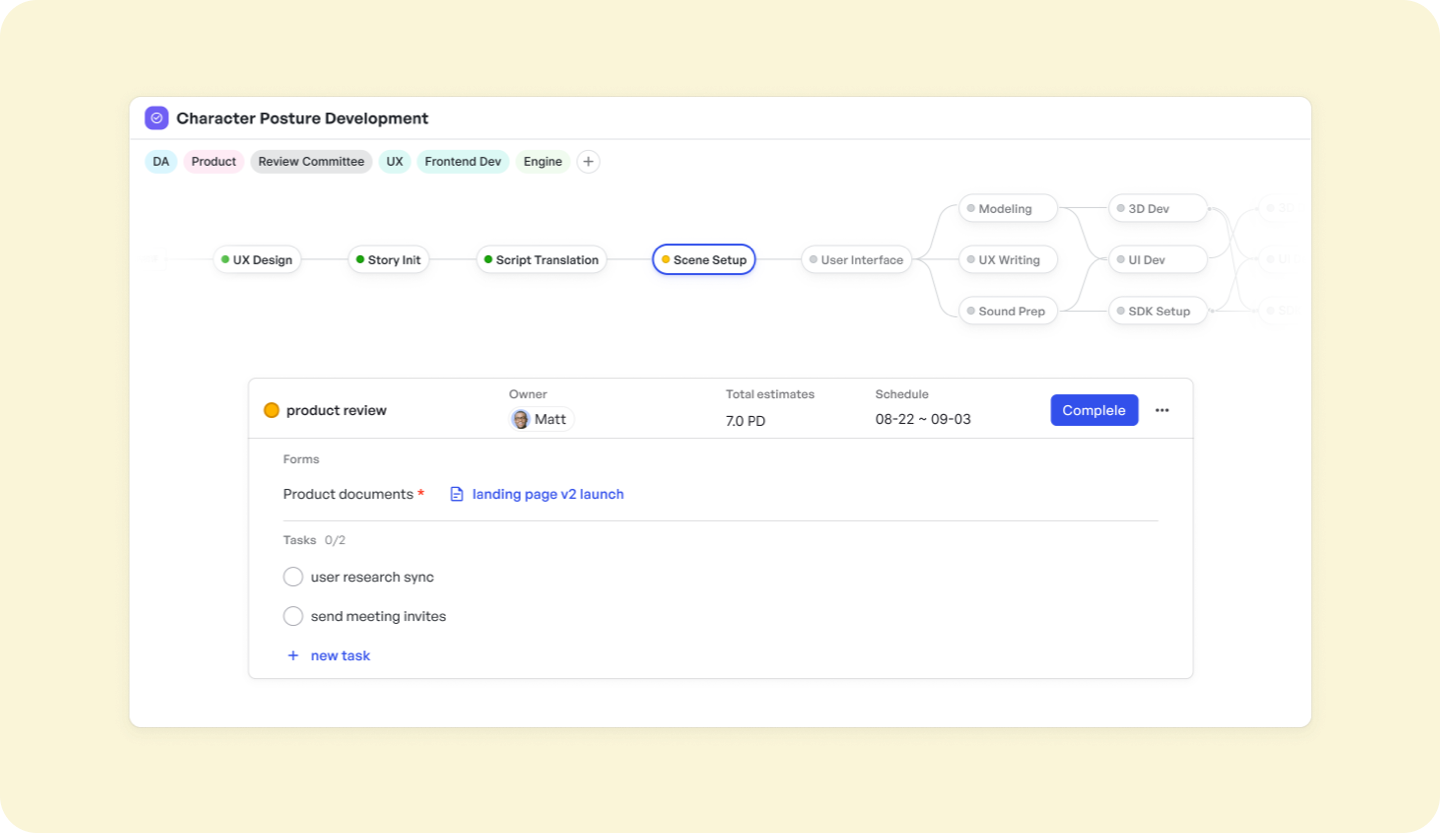 Add product documents
Add product documents- Track decisions and context: Attach research, design mockups, and user stories directly to nodes. This makes it easier to revisit decisions later and maintain alignment as the project evolves.
Step 3: Build a prototype or mockup for early testing
A prototype helps you validate ideas quickly, before investing in development. It shows how your product will look and work, helping you catch usability issues early.
So, before writing code, try different early testing options:
- Low-fidelity wireframes – Test layout and flow
- High-fidelity mockups – Simulate design and aesthetics
- Clickable prototypes – Mimic functionality (e.g., Figma, InVision, Meegle)
Example:
Create a clickable dashboard showing how users might search for feedback and filter it by tag.
- What success looks like: A testable prototype that reflects user flows and feature logic.
- How to measure it: Review quality, design completeness, and internal feedback cycles.
How Meegle measures the success of the prototype:
Meegle's workflow simplifies planning, assigning, and tracking prototype development. It brings design, product, and engineering together around one shared visual.
 Assign roles in Meegle
Assign roles in Meegle- Clarify ownership with role-based assignments: Assign nodes to design, QA, or engineering. Each team member knows what they're responsible for, and you can easily monitor whether key deliverables (e.g., high-fidelity mockups or clickable flows) are on track.
- Break down dependencies early: Use Meegle's visual workflows to highlight which design elements block development or rely on backend setup. That clarity helps you anticipate delays and reassign work as needed.
 Add dependencies in Meegle
Add dependencies in Meegle- Attach prototypes and link tools: You can embed Figma or InVision links directly into Meegle nodes for centralized access. This keeps all design context—wireframes, research, and comments—in one place.
Step 4: Launch to a small audience and collect user feedback
A small-scale launch helps you validate assumptions in a low-risk, focused environment. You'll spot usability issues and surface missing context without overextending your team or damaging trust.
All you need is a targeted release to a group of ideal users or early adopters.
Example:
Invite 50 product managers working at remote-first companies and observe how they perform tasks like "filter feedback by tag" or "track comment threads."
- What success looks like: Actionable user feedback that highlights pain points or confirms the usefulness of a feature
- How to measure it: Track both qualitative insights (user quotes, observed pain points) and quantitative metrics like task success rate, activation, or early churn.
Suggested read: 👉11 Product Management KPIs in 2025 [+ How to Track Them]
How Meegle measures success:
You can use Node Forms to collect structured, qualitative feedback from test users, such as quotes, pain points, and usability observations, directly within each feature or goal node. This creates a centralized record of user sentiment tied to specific parts of your MVP.
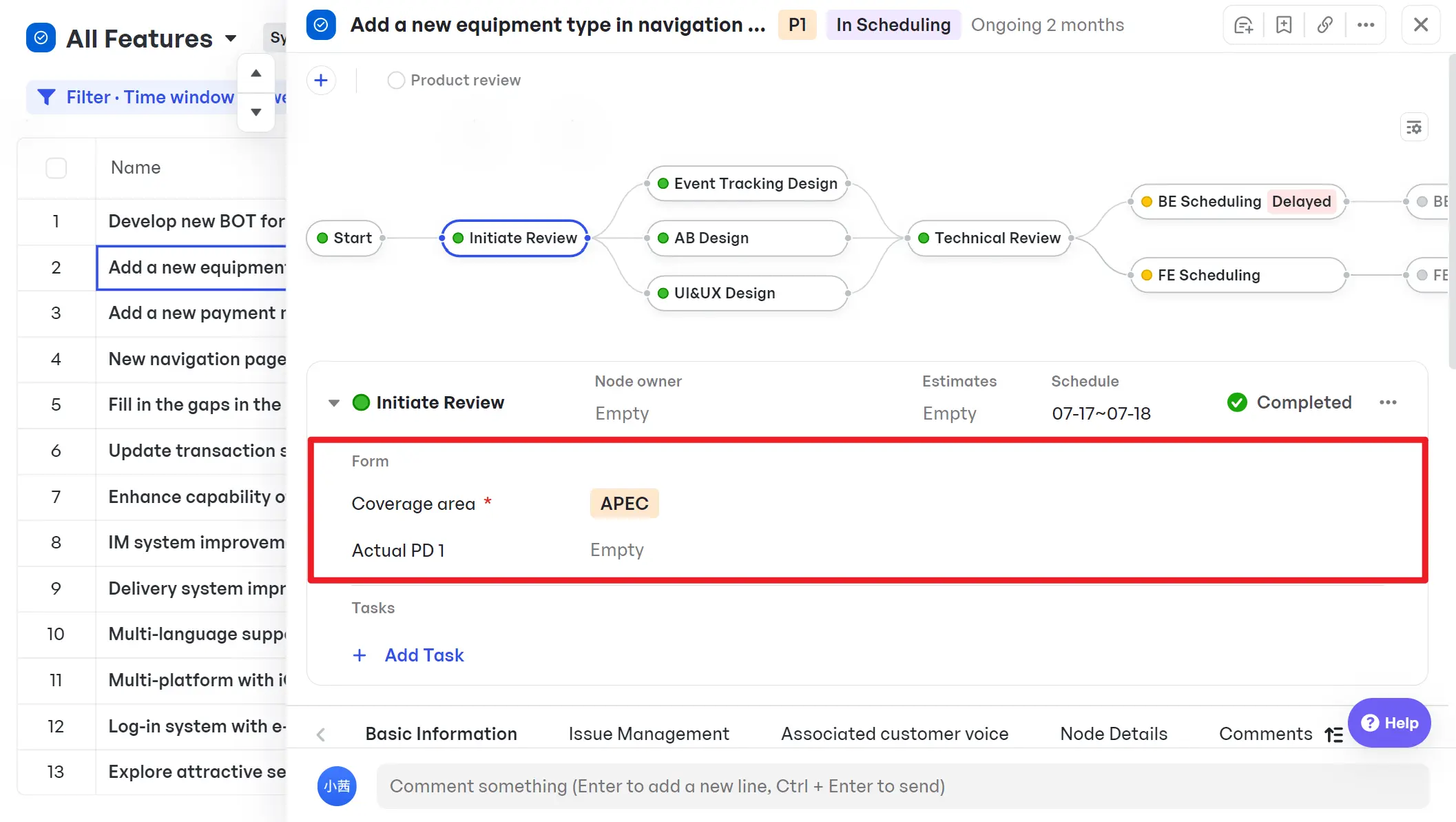 Node forms to gather customer feedback
Node forms to gather customer feedbackAfter, you can layer in Meegle charts to track key validation metrics like:
- Signup rate – measures early interest in your MVP.
- Task completion – reflects how easily users perform critical flows (e.g., filtering feedback or posting a comment).
- Early churn – signals whether your MVP delivers on user expectations beyond first use.
 Different chart options to track the right features
Different chart options to track the right featuresStep 5: Use MVP iteration to build a data-driven roadmap
Post-launch, avoid building based on assumptions. Let user data guide your next move.
Example:
If 80% of users used the tag search but only 10% used advanced filters, improve tagging first. Skip filters (for now).
- What success looks like: An insight-driven product roadmap that reflects user behavior, that adjusts priorities based on what users actually do, not what they say
- How to measure it: Track iteration speed (e.g., average time between MVP releases), impact on key metrics (e.g., improved task success rate or reduced churn), and team alignment (e.g., reduced feedback loops or clearer prioritization).
How to use Meegle to manage MVP iteration:
Meegle's nodes allow you to track:
- Iteration speed: Define milestones and track progress to measure time spent at each stage, helping teams assess efficiency.
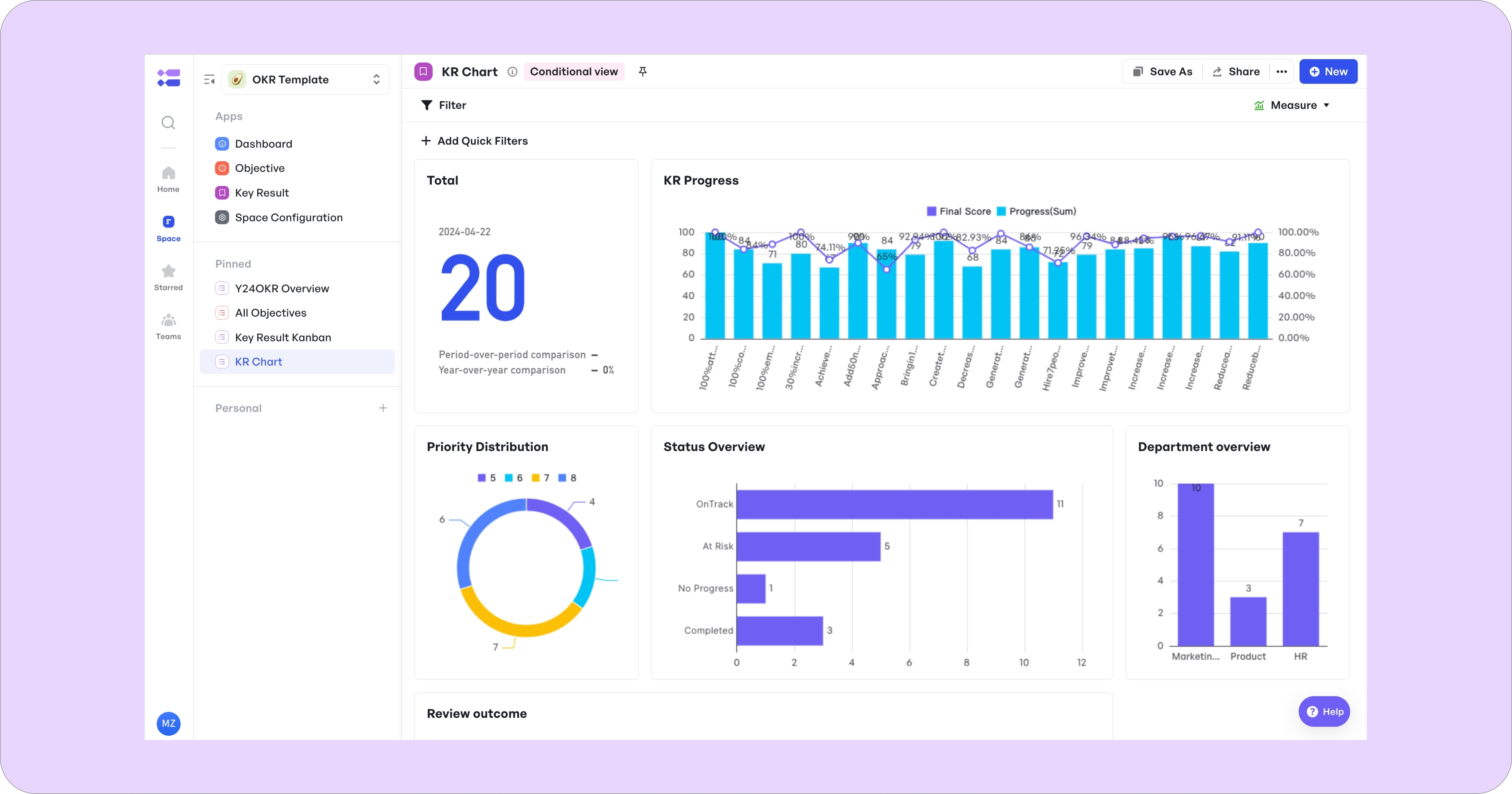 Performance metrics in Meegle Charts
Performance metrics in Meegle Charts- Impact on key metrics: Link product updates to specific metrics (e.g., task success, churn) and track their impact in real-time.
- Team alignment: Use milestones to assign tasks, track dependencies, and ensure team alignment, reducing feedback loops and improving prioritization.
Note: Following the steps listed, it might take you 4–12 weeks to build an MVP that attracts early adopters.
| Step | Time Estimate | What's Involved | Notes |
|---|---|---|---|
| Define the problem and target user | 3–5 days | Market research, stakeholder alignment, user persona creation | Quick alignment with stakeholders using planning tools |
| Outline core functionality | 3–7 days | Feature scoping, prioritization (MoSCoW, ICE), scope alignment | Depends on feature complexity and team agreement |
| Build a prototype or mockup | 1–2 weeks | Wireframes, high-fidelity designs, clickable prototypes | Low-fidelity wireframes can be done in days; high-fidelity clickable prototypes take longer |
| Launch and gather feedback | 2–4 weeks | Private beta, feedback collection, validation metrics | Depends on how long it takes to reach and learn from early users |
| Iterate based on insights | 2–4 weeks | Analyzing results, planning updates, releasing improvements | Iterations should be fast and focused on one or two changes per cycle |
With Meegle, you'll stay on the shorter end of the timeline as your team skips the usual back-and-forth.
Minimum Viable Product Example
Many iconic companies used scrappy MVPs to test assumptions, reduce risk, and validate demand—before investing heavily in product development. These five stand out.
Quick summary:
| Company | MVP Tactic | Problem They Solved | Outcome |
|---|---|---|---|
| Dropbox | Demo video | Validated user interest without building the product | 700M+ users today |
| Airbnb | Rented own apartment | Tested if strangers would pay for a stay | 4M+ hosts, 150M+ users |
| Spotify | Lightweight desktop app | Gauged streaming demand in a piracy-heavy market | 600M+ users globally |
| Zappos | Posted shoe photos, fulfilled manually | Validated comfort with online shoe shopping | Acquired by Amazon for $1.2B |
| Buffer | Landing + pricing page | Tested if people would pay for social scheduling | 140K+ users, profitable SaaS |
Example 1: Dropbox
Dropbox, a cloud-based file storage service, lets users seamlessly access and share files across devices.
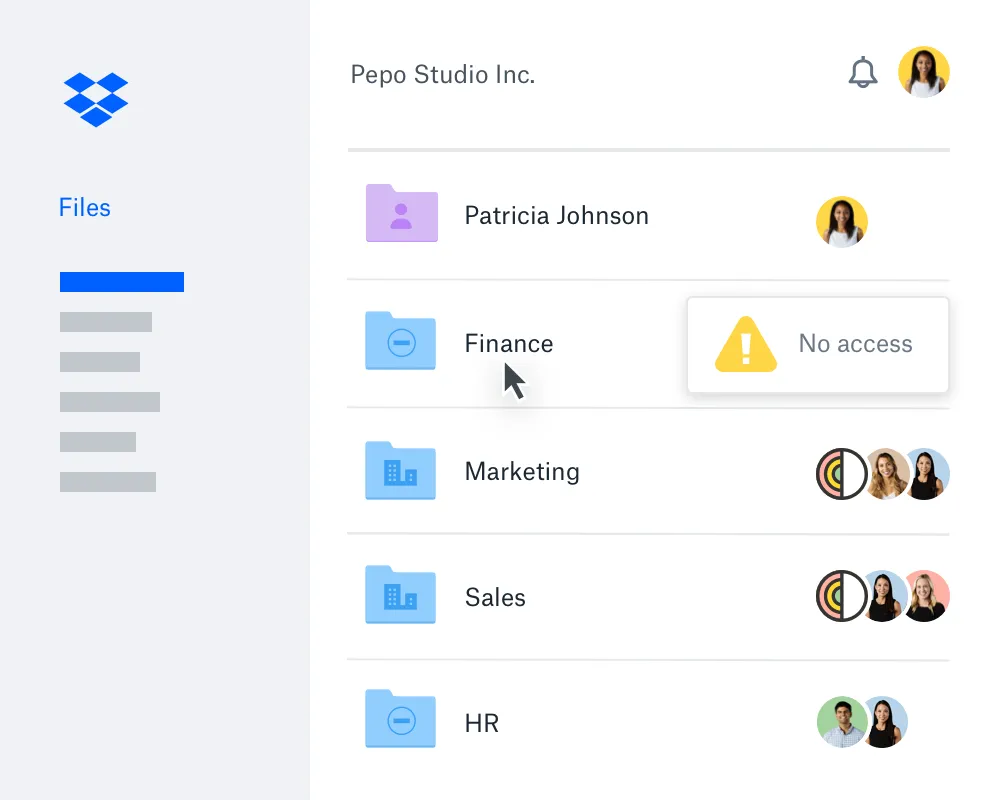 Dropbox link sharing (Source: Dropbox)
Dropbox link sharing (Source: Dropbox)When Dropbox founders struggled to explain their product concept and weren't sure if users would adopt seamless file syncing, they created a simple demo video. Without writing a line of code, the video went viral on Hacker News, leading to a massive waitlist. Today, Dropbox serves over 700 million users worldwide (DBX Fact Sheet).
Takeaway: By testing with a simple, low-cost demo, Dropbox validated the demand for their product before building it, ensuring a high-interest launch.
Example 2: Airbnb
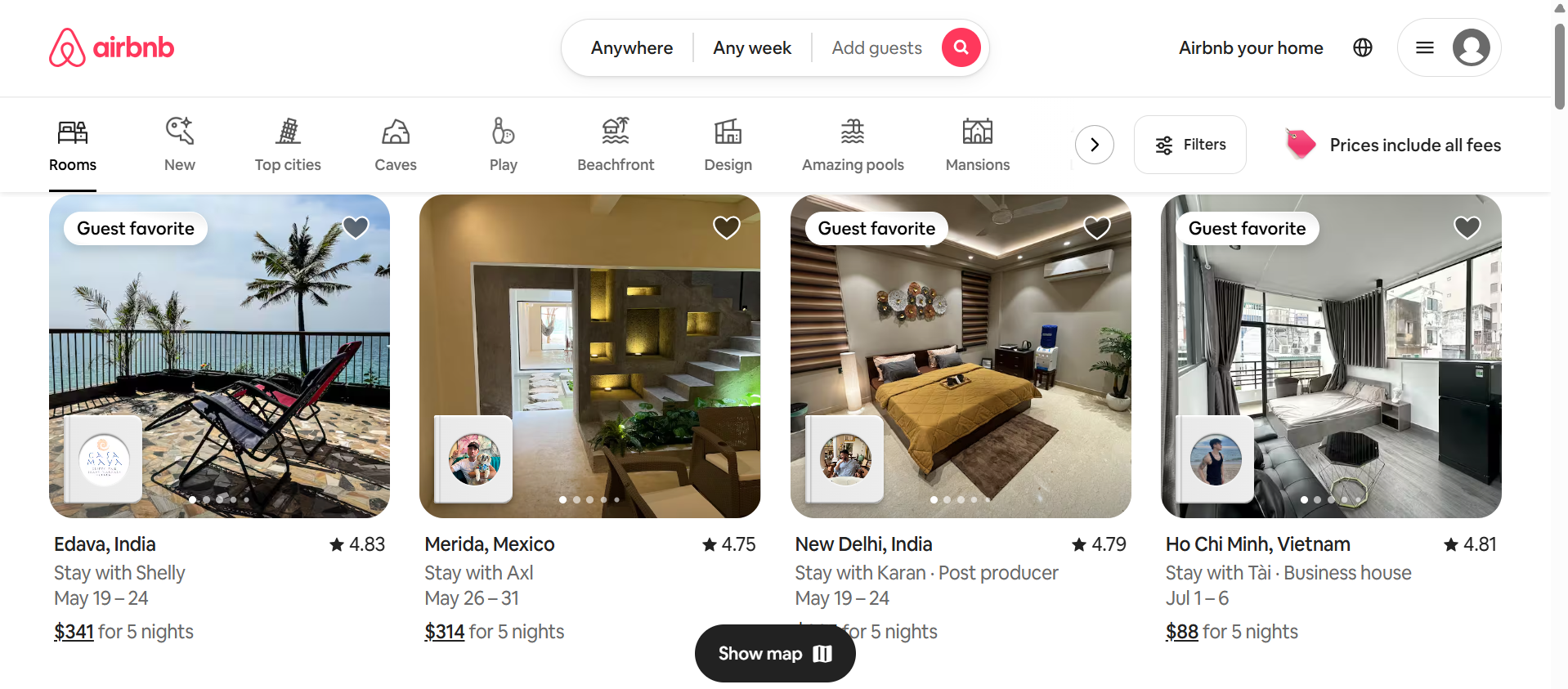 Airbnb homepage (Source:Airbnb)
Airbnb homepage (Source:Airbnb)Airbnb, a marketplace connecting hosts and travelers, started with the founders testing a simple idea—renting out their apartment during a local conference to see if people would pay to stay in a stranger’s home. The test succeeded, leading to Airbnb's rapid growth to over 4 million hosts and 150 million users across 220+ countries (The Zebra).
Takeaway: Airbnb's MVP approach helped validate demand with minimal investment, guiding their decision to scale.
Example 3: Spotify
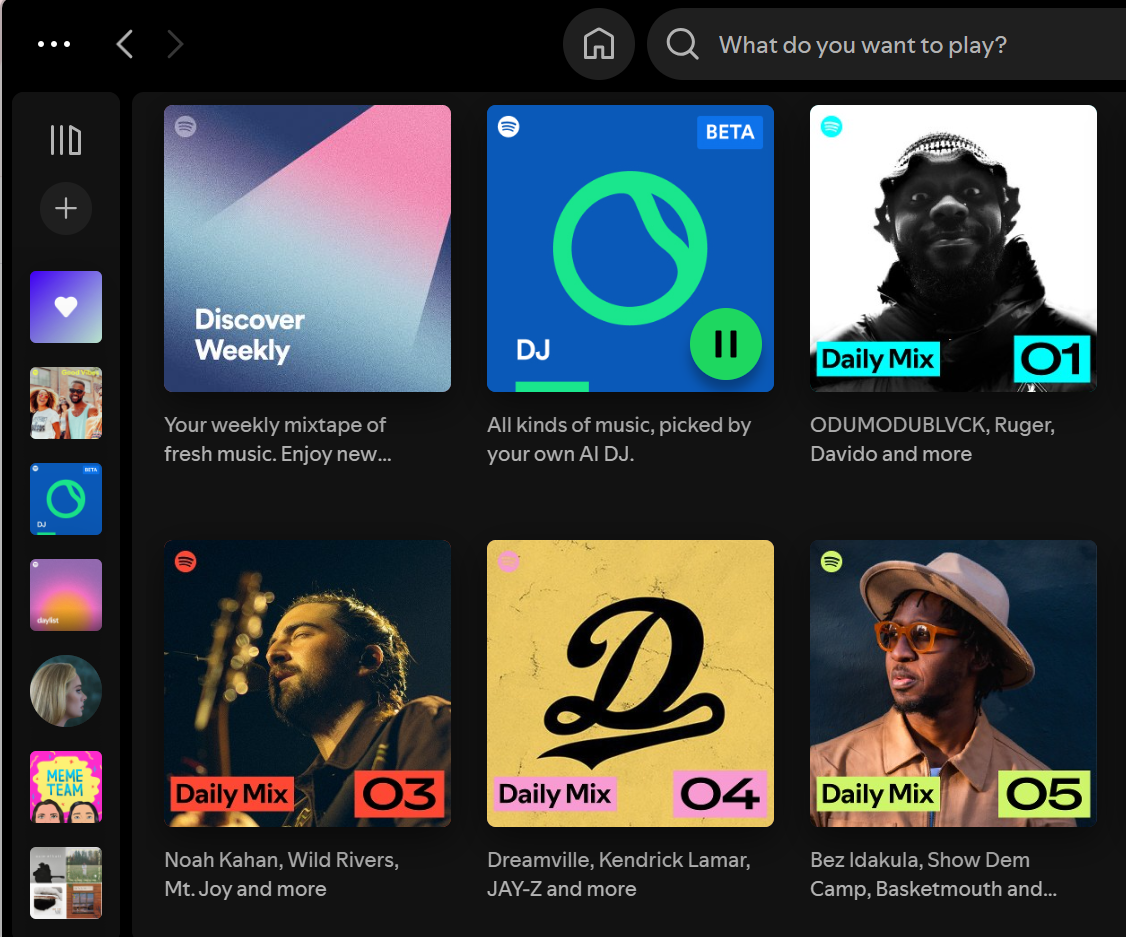 Spotify player
Spotify playerSpotify launched a lightweight desktop app in Sweden to test the streaming model. This approach was essential for understanding if users would embrace the idea of streaming instead of downloading songs, especially with concerns around piracy and bandwidth.
The test showed strong user adoption, leading Spotify to scale and dominate the global music streaming market with over 678 million users (Spotify Newsroom).
Takeaway: Spotify's MVP validated the core assumption before a full launch, reducing risk and aligning their offering with user demand.
Example 4: Zappos
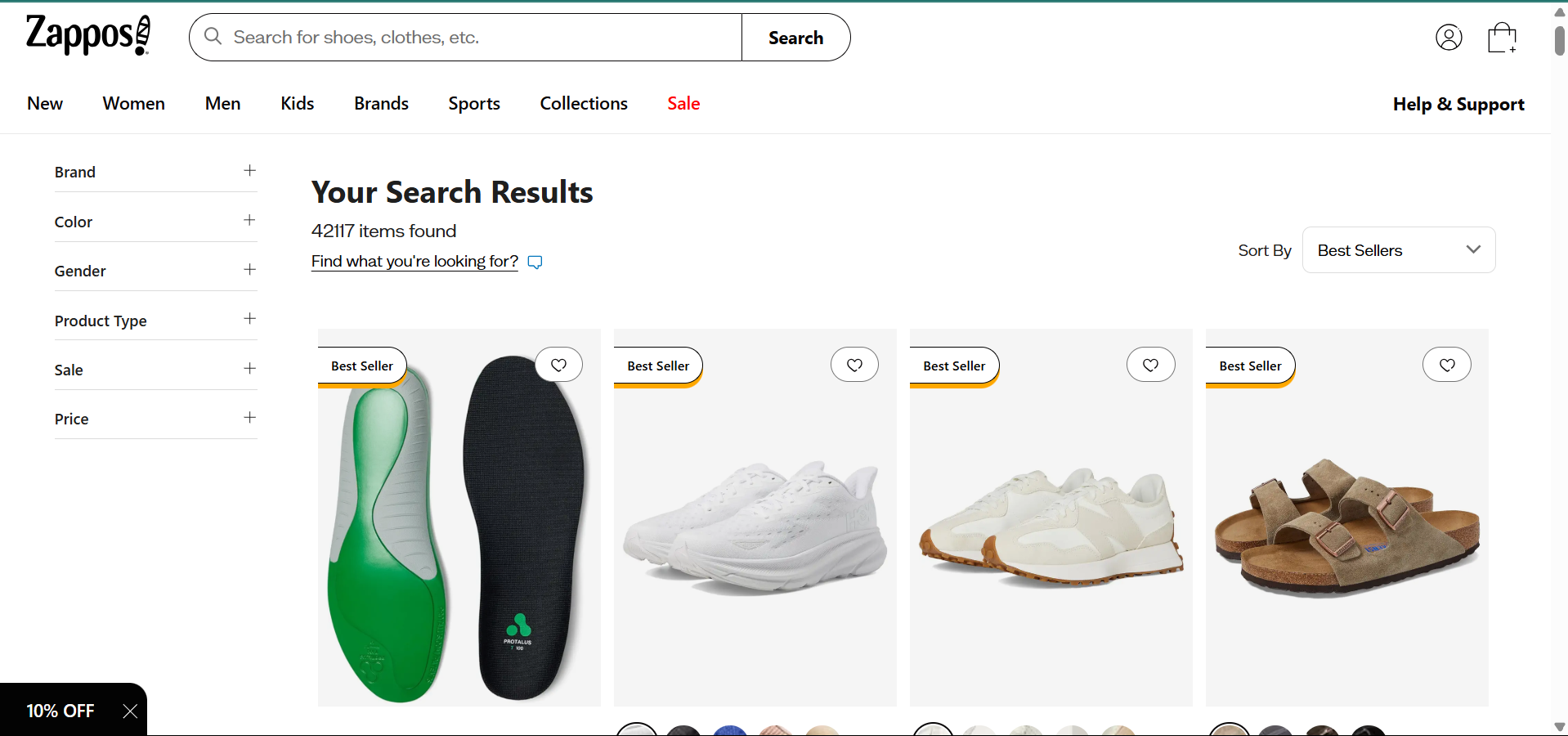 Zappos kids accessories (Source: Zappos)
Zappos kids accessories (Source: Zappos)Zappos started by testing the market with a simple MVP—posting pictures of shoes online and fulfilling orders by buying them from local stores after customers paid.
This MVP validated the idea, leading to Zappos scaling rapidly and eventually being acquired by Amazon for $1.2 billion (Fast Company).
Takeaway: Zappos' MVP showed that with the right test, even unconventional ideas could become multi-billion-dollar businesses.
Example 5: Buffer
 Buffer Analyze tool (Source: Buffer)
Buffer Analyze tool (Source: Buffer)Buffer's founder created a simple 2-page landing page explaining the concept of the tool and followed it with a pricing page to test users' willingness to pay.
 Buffer's two-page MVP (Source: Buffer)
Buffer's two-page MVP (Source: Buffer)The response confirmed strong demand, leading to the quick launch of Buffer, which now supports over 140,000 users and generates millions in recurring revenue.
Takeaway: Buffer's MVP—testing a landing page—proved the power of validating demand before building, a strategy that drove its rapid success.
Each of these brands solved a specific challenge, just by starting small. These stories show that MVPs don’t have to be complex to be powerful. The key is in testing fast, learning fast, and evolving with users.
Are MVPs only for startups?
Not at all.
While startups popularized the MVP approach to move fast and stay lean, enterprises use MVPs. This trend is common, especially when entering new markets, testing features, or launching internal tools.
Here's why MVPs work beyond startups:
- Enterprise Innovation: Large companies use MVPs to test new ideas before scaling. For example, Google tested Gmail internally before public release, and Amazon piloted Prime Wardrobe quietly before expanding.
- Risk Reduction: MVPs allow enterprises to validate concepts early, avoiding costly mistakes. Microsoft, for instance, tested Teams internally before competing with Slack, minimizing the risk of failure.
- Agility: Large organizations, like Walmart and Nike, use MVPs to quickly launch internal tools or new product features, enabling faster iterations and leaner development cycles.
That's your cue if you're a product leader on the fence. FYI, we have one more success story for you.
How LIZHI cut release time by 50% using Meegle
The challenge:
LIZHI, a leading audio platform, needed a faster, more structured way to release new products. Their existing tools made it hard to track goals and align teams. Unfortunately, that slowed down testing MVPs and iterations.
What Meegle did:
Meegle helped LIZHI streamline product development using its node-based workflow, milestone tracking, and cross-functional planning tools.
- With shared visibility across the teams, LIZHI could map each goal to a node, assign clear owners, and reduce ambiguity.
 Streamlined workflow for successful MVPs
Streamlined workflow for successful MVPs- Real-time collaboration features eliminate delays, while milestone tracking ensures accountability at every step.
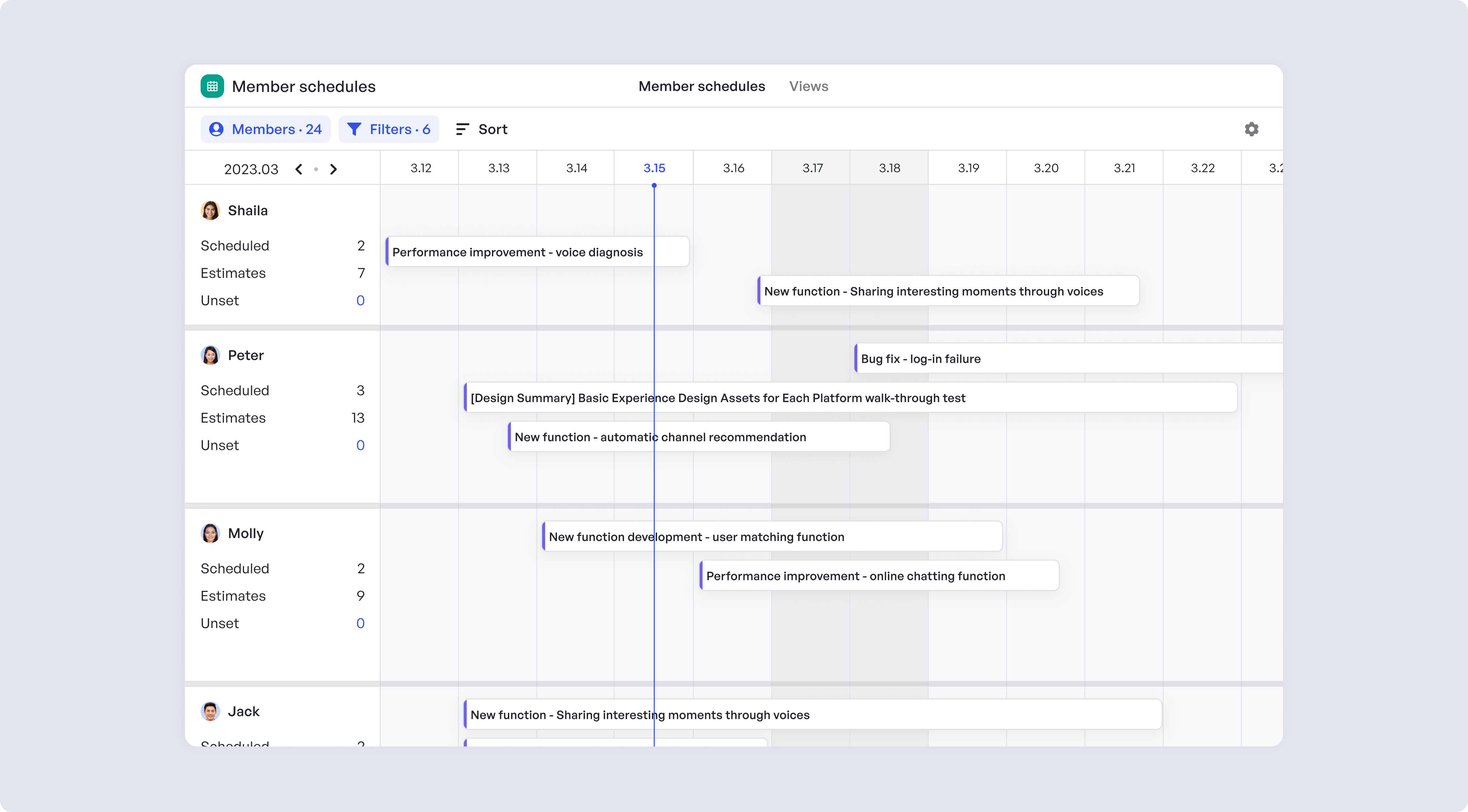 Real-time collaboration and milestone tracking
Real-time collaboration and milestone trackingThe result? Tighter execution and a 50% cut in release time.
The client's feedback:
"After integrating Meegle, we have witnessed a substantial surge in the number of deliverables, a notable enhancement in version iteration efficiency, and a consistent reduction of at least 50% in the average delivery cycle that has persisted for multiple quarters."
Yibin Huang | Head of Operation and Quality Department at LIZHI
LIZHI’s success shows what’s possible with structured execution. Their story highlights how Meegle accelerates MVP delivery for cross-functional teams.
Want to build MVPs faster, too?
Use Meegle for free today and uncover how much time you’ll save every day
FAQs
How do I know when my new product is "ready" to launch?
Your MVP is ready when it solves a core user problem and gathers actionable feedback. Focus on essential features to validate your idea and iterate using validated learning about customers.
What if my MVP doesn't get the feedback I expect? Should I keep pushing forward or pivot?
If feedback is poor, use it to pivot or refine. Negative feedback is valuable for learning and improving the product's user interface, not a reason to continue unchanged.
How does an MVP help improve product-market fit?
An MVP tests market demand with real users, providing feedback to refine the product. Then, you can add extra features. Ultimately, your minimum marketable product will better align with market needs, improving product-market fit.
The world’s #1 visualized project management tool
Powered by the next gen visual workflow engineRead More
Check All BlogsStart creating impactful work today



